By Leen Randell
Updated: Jul 04, 2024
10 Best Herbal Decoctions For Insect Bites
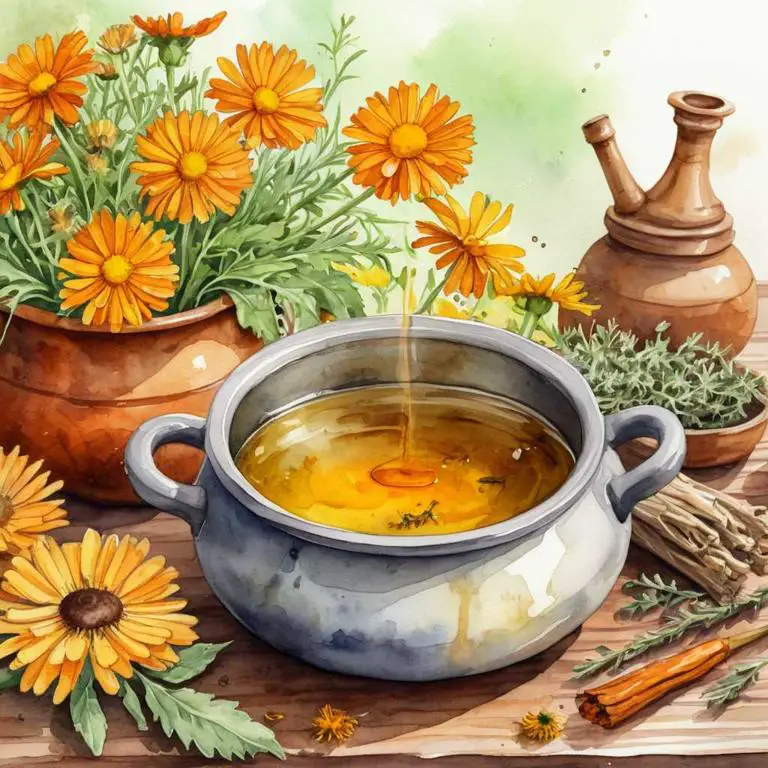
Herbal decoctions for insect bites are a natural remedy that involves steeping herbs in hot water to create a soothing liquid extract.
This concoction helps alleviate the discomfort and itching caused by insect bites, reducing inflammation and promoting healing. Examples of herbal decoctions that provide relief from insect bites include peppermint, lavender, and chamomile. These decoctions can be applied topically or consumed as a tea, providing instant relief and improving overall well-being.
For instance, a person who suffered from severe mosquito bites on a camping trip found relief by drinking a chamomile decoction, allowing them to enjoy the rest of their adventure without discomfort.
The following article describes in detail the most important decoctions for insect bites, including medicinal properties, parts of herbs to use, and recipes for preparations.
- 1. Calendula officinalis
- 2. Hypericum perforatum
- 3. Arnica montana
- 4. Echinacea angustifolia
- 5. Plantago major
- 6. Urtica dioica
- 7. Aloe vera
- 8. Mentha x piperita
- 9. Lavandula angustifolia
- 10. Matricaria chamomilla
- What is the best combination of herbal decoctions to use for insect bites?
- What ailments similar to insect bites are treated with herbal decoctions?
1. Calendula officinalis
Pot marigold decoctions helps with insect bites because of its anti-inflammatory and antiseptic properties.
The flavonoids and phenolic acids present in the plant reduce swelling, redness, and itching associated with bug bites. The decoction's antimicrobial activity also prevents infection and promotes healing by reducing the growth of bacteria and other microorganisms on the skin.
Additionally, pot marigold's analgesic properties provide relief from pain and discomfort caused by insect bites, making it a natural remedy for soothing irritated skin.

Medicinal Constituents
The list below shows the primary medicinal constituents in Calendula officinalis decoctions that help with insect bites.
- Triterpenoids: These compounds have anti-inflammatory and antiseptic properties that help reduce swelling, redness, and infection associated with insect bites, promoting faster healing.
- Phenolic acids: These compounds exhibit strong antioxidant and anti-inflammatory effects, which help alleviate pain, itching, and inflammation caused by insect bites.
- Carotenoids: As a powerful antioxidant, beta-carotene helps protect the skin from oxidative damage, reducing inflammation and promoting the healing process after an insect bite.
Parts Used
The list below shows the primary parts of pot marigold used to make decoctions for insect bites.
- Flowers: They are used due to their anti-inflammatory and antiseptic properties, which help soothe and calm irritated skin.
- Leaves: They are used because they contain flavonoids and other compounds that aid in reducing redness and swelling caused by insect bites.
- Roots: They are used for their antimicrobial properties, which help prevent infection and promote healing of insect bite wounds.
Quick Recipe
The following recipe gives a procedure to make a basic pot marigold for insect bites.
- Gather 20-30 fresh or dried calendula flowers and clean them thoroughly with filtered water.
- Combine the cleaned calendula flowers with 1 quart of water in a medium saucepan and bring to a boil.
- Reduce the heat to a simmer for 20-25 minutes allowing the mixture to infuse and release its properties.
- Strain the mixture through a cheesecloth or a fine-mesh sieve into a bowl discarding the solids.
- Allow the decoction to cool before transferring it to a clean glass bottle for storage and future use.
2. Hypericum perforatum
St John's Wort decoctions helps with insect bites because of its natural anti-inflammatory properties.
The decoction, which is made by steeping the plant's leaves and flowers in hot water, can be applied topically to reduce swelling and itching caused by bug bites. The active compound hyperforin has been shown to have analgesic and antihistamine effects, providing quick relief from insect bite discomfort.
Additionally, St John's Wort decoctions may also help prevent infection and promote wound healing.
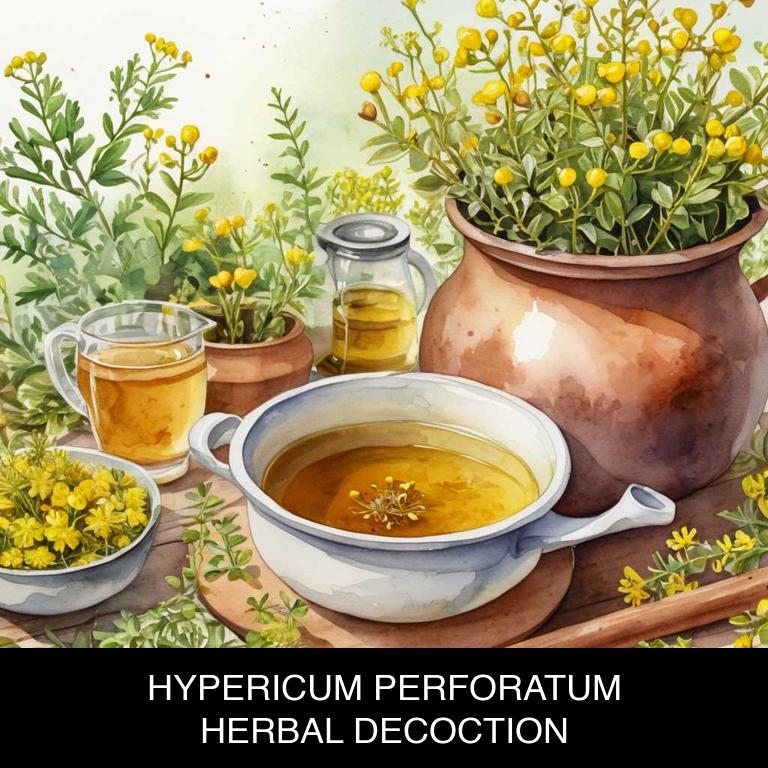
Medicinal Constituents
The list below shows the primary medicinal constituents in Hypericum perforatum decoctions that help with insect bites.
- Hyperforin: Hyperforin has anti-inflammatory and analgesic properties, helping to reduce pain, swelling, and itching associated with insect bites.
- Quercetin: Quercetin is a flavonoid that acts as an antihistamine, inhibiting the release of histamine, which causes allergic reactions, including itching, redness, and swelling, due to insect bites.
- N-feruloyltyramine: N-feruloyltyramine has anti-inflammatory and antipruritic (anti-itch) effects, helping to alleviate itching, redness, and swelling caused by insect bites.
Parts Used
The list below shows the primary parts of st john's wort used to make decoctions for insect bites.
- Leaves: Known for their anti-inflammatory and antiseptic properties, which help soothe and calm irritated skin caused by insect bites.
- Flowers: Used for their antiseptic, anti-inflammatory, and antihistamine properties, which aid in reducing itching, swelling, and redness from insect bites.
- Roots: Utilized for their anti-inflammatory and antimicrobial properties, which help to reduce pain, swelling, and infection caused by insect bites.
Quick Recipe
The following recipe gives a procedure to make a basic st john's wort for insect bites.
- Harvest fresh hypericum perforatum flowers and leaves in the morning after the dew has evaporated.
- Chop the plant material into smaller pieces using scissors to increase the surface area.
- Combine 2-3 tablespoons of chopped plant material with 1 quart of boiling water in a saucepan.
- Simmer the mixture for 5-10 minutes over low heat to extract the active compounds.
- Strain the decoction through a cheesecloth or a fine-mesh sieve into a clean container.
3. Arnica montana
Mountain arnica decoctions helps with insect bites because of its natural anti-inflammatory properties, which quickly reduce swelling and redness.
The decoction's antiseptic qualities also prevent infection by killing bacteria that can cause further irritation. Additionally, arnica's soothing effects calm itching and discomfort, allowing the skin to heal faster.
As a result, herbal mountain arnica decoctions provide instant relief from insect bites, making them a natural and effective remedy for reducing discomfort and promoting rapid recovery.
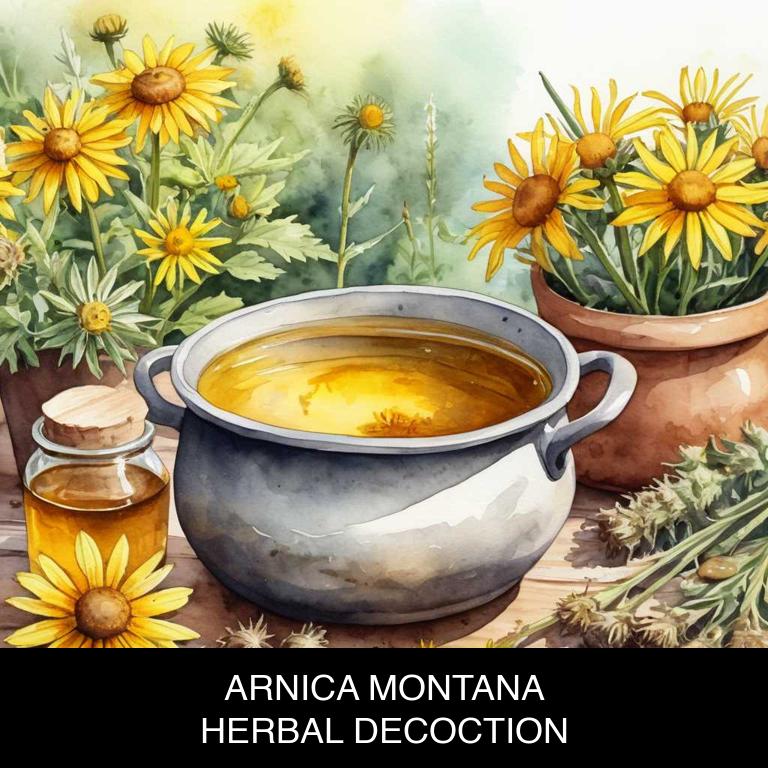
Medicinal Constituents
The list below shows the primary medicinal constituents in Arnica montana decoctions that help with insect bites.
- Flavonoids: These plant compounds help reduce inflammation and itching associated with insect bites by inhibiting the release of histamine and other pro-inflammatory mediators.
- Triterpenes: Triterpenes present in Arnica montana, such as arnidiol and arnidiol-3-O-butyrate, possess anti-inflammatory and antioxidant properties, which aid in soothing and calming irritated skin caused by insect bites.
- Phenolic acids: Phenolic acids in Arnica montana, like caffeic acid and ferulic acid, exhibit antioxidant and anti-inflammatory activities, helping to mitigate the redness, swelling, and discomfort caused by insect bites.
Parts Used
The list below shows the primary parts of mountain arnica used to make decoctions for insect bites.
- Flowers: They are used due to their anti-inflammatory and soothing properties.
- Leaves: They are used for their ability to reduce itching and swelling caused by insect bites.
- Roots: They are used for their anti-inflammatory and antiseptic properties, which help to reduce pain and promote healing.
Quick Recipe
The following recipe gives a procedure to make a basic mountain arnica for insect bites.
- Harvest 30-60 grams of fresh arnica montana flowers or 15-30 grams of dried flowers.
- Chop the harvested arnica montana flowers into small pieces to increase surface area.
- Combine the chopped arnica montana flowers with 1 liter of water in a saucepan.
- Bring the mixture to a boil then reduce heat and simmer for 10-15 minutes.
- Strain the decoction through a cheesecloth or a fine-mesh sieve into a clean container.
4. Echinacea angustifolia
Kansas coneflower decoctions helps with insect bites because they contain potent anti-inflammatory and antiseptic compounds, such as echinacoside and sesquiterpenes.
These natural components work together to reduce swelling and itching caused by insect bites, while also preventing infection and promoting healing.
The decoction's antipruritic properties help alleviate discomfort and relieve the intense itching associated with bug bites, making it a soothing and effective solution for calming irritated skin.
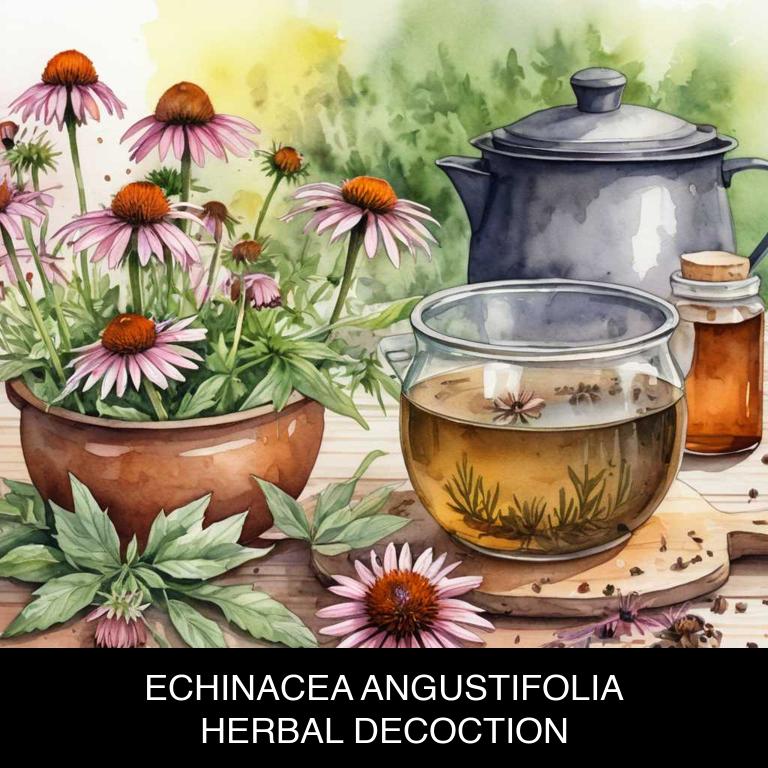
Medicinal Constituents
The list below shows the primary medicinal constituents in Echinacea angustifolia decoctions that help with insect bites.
- Iridoid glycosides: These compounds have anti-inflammatory properties, which can help reduce the swelling and redness associated with insect bites.
- Flavonoids: As antioxidants and anti-inflammatory agents, flavonoids can help soothe the skin, reduce pain, and prevent secondary infections caused by insect bites.
- Alkamides: These compounds have been shown to have anti-inflammatory and antimicrobial properties, which can help alleviate symptoms of insect bites, such as pain, swelling, and redness.
Parts Used
The list below shows the primary parts of kansas coneflower used to make decoctions for insect bites.
- Roots: The roots are the primary part used due to their high concentration of alkaloids, particularly echinacoside, which has anti-inflammatory and antiseptic properties.
- Leaves: The leaves are used for their ability to provide a soothing and cooling effect when applied topically to insect bites, reducing itching and inflammation.
- Flowers: The flowers are often used in decoctions for their anti-inflammatory and antiseptic properties, which help to reduce swelling and prevent infection in insect bites.
Quick Recipe
The following recipe gives a procedure to make a basic kansas coneflower for insect bites.
- Gather 2-4 grams of dried roots and 1 liter of cold water to prepare the herbal decoction.
- Cut the dried roots into smaller pieces to increase their surface area for infusion.
- Combine the cut roots with cold water in a saucepan and bring the mixture to a boil.
- Reduce the heat and let the decoction simmer for 10-15 minutes to release the active compounds.
- Strain the decoction through a cheesecloth or a fine-mesh sieve to remove the roots and discard the solids.
5. Plantago major
Plantain decoctions helps with insect bites because of its anti-inflammatory, antimicrobial, and analgesic properties.
The decoction's active compounds, such as allantoin and cinnamic acid, help to reduce swelling and itching caused by insect stings or bites. Additionally, the antiseptic properties of plantain work to prevent infection and promote healing.
This natural remedy soothes and calms the skin, providing quick relief from itchy and painful insect bites.
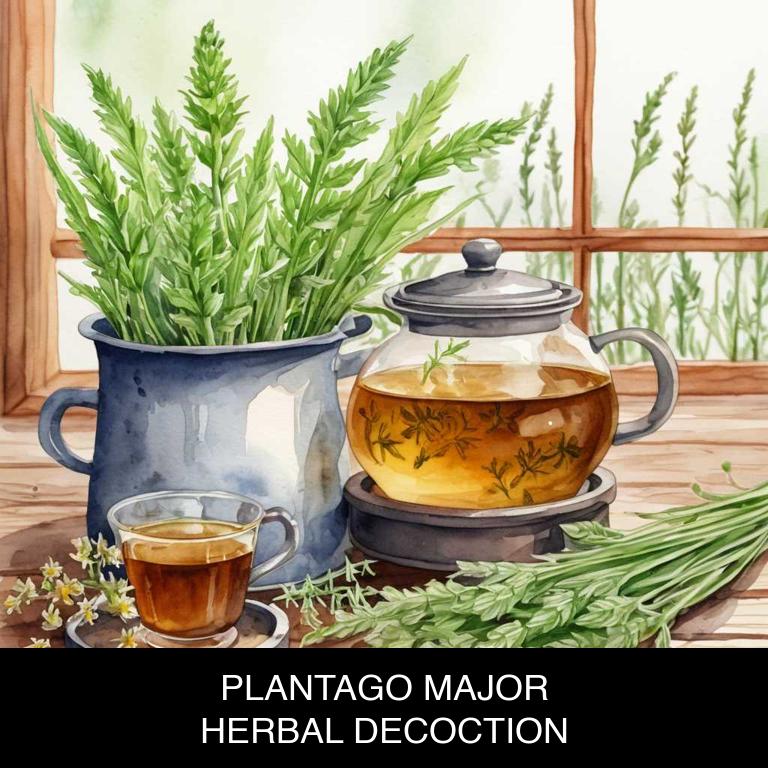
Medicinal Constituents
The list below shows the primary medicinal constituents in Plantago major decoctions that help with insect bites.
- Apolactones: Apolactones, a type of flavonoid glycoside, help with insect bites by exhibiting anti-inflammatory and antihistaminic properties, which can reduce redness, itching, and swelling caused by insect bites.
- Apolavin: Apolavin, a flavonoid glycoside, helps with insect bites by showing potent antioxidant and anti-inflammatory activities, which can protect the skin from oxidative damage and reduce the severity of insect bite symptoms.
- Tannins: Tannins, a type of polyphenol, help with insect bites by exhibiting astringent properties, which can help to reduce swelling, itching, and redness caused by insect bites, and also aid in the healing of the affected area.
Parts Used
The list below shows the primary parts of plantain used to make decoctions for insect bites.
- Leaves: The leaves are the most commonly used part of Plantago major for decoctions due to their high concentration of anti-inflammatory compounds.
- Stems: Stems are used in decoctions to take advantage of their astringent properties, which help to reduce swelling and itching from insect bites.
- Roots: Roots are used in decoctions for their anti-inflammatory and antiseptic properties, which help to soothe and protect the affected area from infection.
Quick Recipe
The following recipe gives a procedure to make a basic plantain for insect bites.
- Harvest 50-100 grams of dried plantago major leaves and flowers in the morning on a dry day.
- Chop the harvested plantago major into small pieces to increase the surface area for infusion.
- Combine the chopped plantago major with 1 liter of water in a saucepan and bring to a boil.
- Reduce the heat and simmer the plantago major decoction for 10-15 minutes to allow the active compounds to release.
- Strain the decoction through a cheesecloth or fine mesh into a clean container to remove the plantago major solids.
6. Urtica dioica
Stinging nettle decoctions helps with insect bites because of its anti-inflammatory, antihistamine, and antimicrobial properties.
The decoction's soothing and cooling effect can reduce swelling and itching caused by insect bites, providing instant relief. The antioxidants present in the nettle also help to neutralize the toxins released from the insect's saliva during biting, further reducing inflammation and promoting healing.
By using stinging nettle decoctions, individuals can effectively alleviate discomfort and promote a speedy recovery from insect bites.
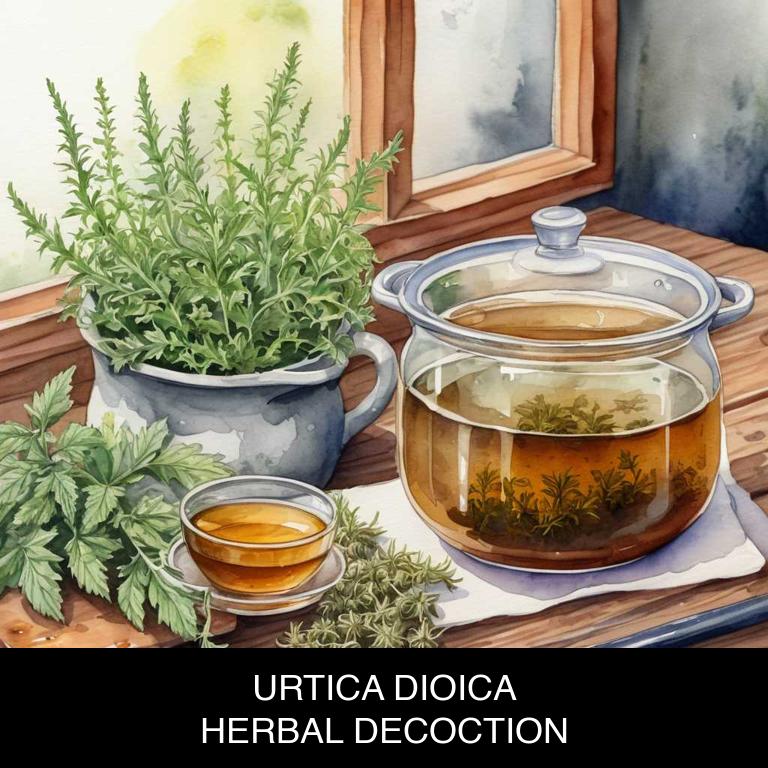
Medicinal Constituents
The list below shows the primary medicinal constituents in Urtica dioica decoctions that help with insect bites.
- Alkaloids: Specifically, the alkaloids in Urtica dioica, such as stachydrine and histamine, help counteract the allergic responses triggered by insect bites, reducing inflammation and itching.
- Phenolic acids: These compounds have anti-inflammatory properties, which can help alleviate the pain and swelling associated with insect bites.
- Polysaccharides: These complex carbohydrates can help soothe and protect the skin, reducing irritation and promoting the healing of insect bite lesions.
Parts Used
The list below shows the primary parts of stinging nettle used to make decoctions for insect bites.
- Leaves: The leaves are the most commonly used part for their high content of histamine-releasing compounds, which help reduce swelling and itching caused by insect bites.
- Stems: The stems of Urtica dioica contain anti-inflammatory compounds that help soothe and calm the skin, reducing redness and discomfort caused by insect bites.
- Roots: The roots of the plant are used for their ability to reduce inflammation and itching, making them an effective ingredient in decoctions for treating insect bite symptoms.
Quick Recipe
The following recipe gives a procedure to make a basic stinging nettle for insect bites.
- Harvest urtica dioica leaves and stems from a clean and unpolluted area in late spring or early summer.
- Rinse the harvested urtica dioica plant material in a fine mesh sieve under cold running water.
- Combine 1 cup of the rinsed urtica dioica plant material with 4 cups of water in a saucepan.
- Bring the plant material and water mixture to a boil then reduce heat and simmer for 10 minutes.
- Strain the decoction through a fine mesh sieve and discard the solids then serve the liquid.
7. Aloe vera
Aloe decoctions helps with insect bites because of its anti-inflammatory, antiseptic, and soothing properties.
The gel-like substance within aloe vera contains compounds such as aloin and aloe-emodin, which work together to reduce swelling and redness caused by insect bites. Additionally, the natural antibacterial agents in aloe help prevent infection and promote healing.
By applying an aloe decoction topically, individuals can quickly alleviate discomfort, itching, and pain associated with insect bites, providing relief and promoting faster recovery.
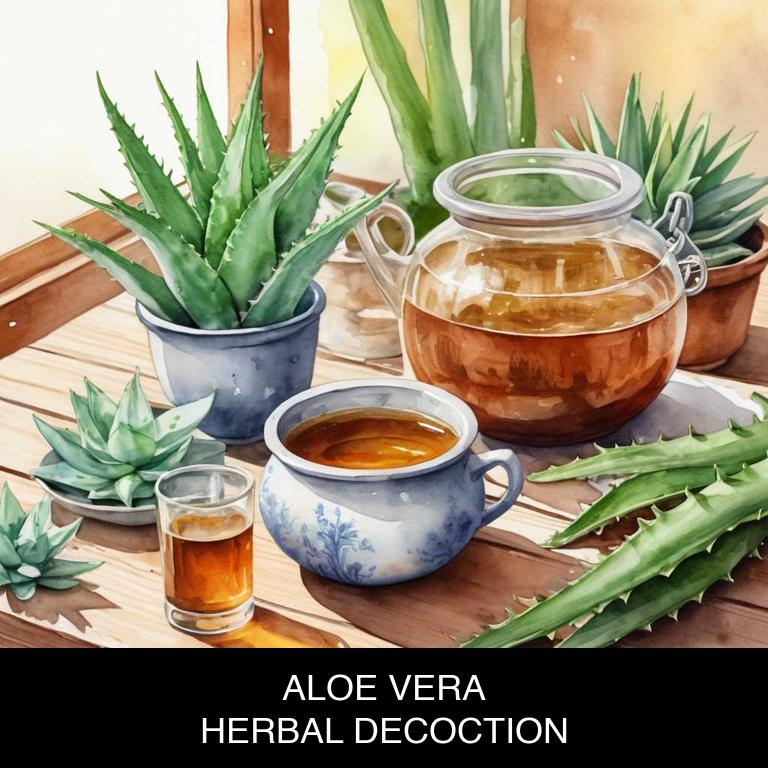
Medicinal Constituents
The list below shows the primary medicinal constituents in Aloe vera decoctions that help with insect bites.
- Catechins: These polyphenolic compounds help reduce inflammation and alleviate itching caused by insect bites by inhibiting the production of pro-inflammatory cytokines.
- Aloe-emodin: This anthraquinone derivative has anti-inflammatory and antiseptic properties, which help soothe and calm the skin affected by insect bites, reducing redness and swelling.
- Beta-sitosterol: This phytosterol has anti-inflammatory and antiseptic properties, which help reduce the severity of allergic reactions to insect bites, such as redness, swelling, and itching.
Parts Used
The list below shows the primary parts of aloe used to make decoctions for insect bites.
- Leaves: Aloe vera leaves are rich in gel and other compounds that help soothe and reduce inflammation caused by insect bites.
- Leaves (specifically the inner gel): The inner gel of Aloe vera leaves contains anti-inflammatory and anti-itch properties that help alleviate symptoms of insect bites.
- Leaves (specifically the outer sap or latex): The outer sap or latex of Aloe vera leaves has anti-inflammatory and antimicrobial properties that help combat infection and reduce swelling caused by insect bites.
Quick Recipe
The following recipe gives a procedure to make a basic aloe for insect bites.
- Harvest fresh aloe vera leaves in the morning when they are at their most potent 500mg to 1000mg of leaf material is ideal.
- Clean and peel the leaves to remove the outer green skin and the spiny edges to avoid irritation.
- Chop the peeled leaves into small pieces and weigh them to ensure accurate dosing 500mg to 1000mg is recommended.
- Boil the chopped aloe vera in 500ml of water for 10 to 15 minutes to release the active compounds.
- Strain the decoction and discard the solids to create a clear liquid herbal remedy.
8. Mentha x piperita
Peppermint decoctions helps with insect bites because of its natural anti-inflammatory and soothing properties.
When applied topically to affected areas, peppermint's cooling effect can reduce swelling and ease itching caused by insect stings or bites. Additionally, peppermint's antioxidant compounds help neutralize histamine release, which further reduces inflammation and discomfort.
As a result, peppermint decoctions provide fast and effective relief from the itchy, painful symptoms associated with insect bites, making them a popular natural remedy for soothing skin irritation.
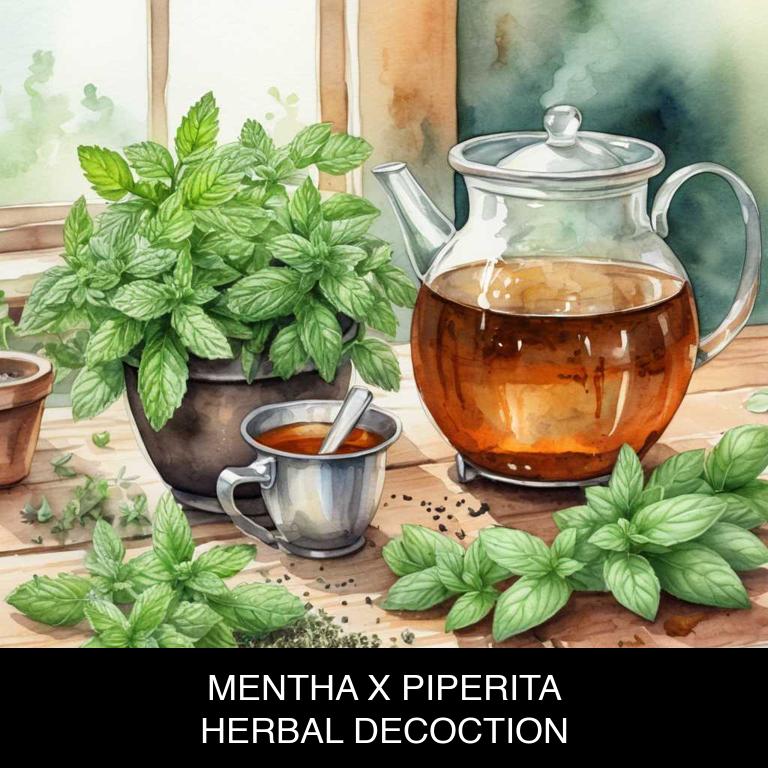
Medicinal Constituents
The list below shows the primary medicinal constituents in Mentha x piperita decoctions that help with insect bites.
- Menthol: Menthol, a terpene compound found in peppermint, helps with insect bites by cooling the skin, reducing itching and inflammation.
- Rosmarinic acid: Rosmarinic acid, a phenolic compound found in peppermint, has anti-inflammatory and antioxidant properties that help alleviate the symptoms of insect bites, such as redness and swelling.
- Caryophyllene oxide: Caryophyllene oxide, a sesquiterpene found in peppermint, has anti-inflammatory and antipruritic properties that help to soothe and calm the skin after an insect bite.
Parts Used
The list below shows the primary parts of peppermint used to make decoctions for insect bites.
- Leaves: The leaves of Mentha x piperita are the most commonly used part to make decoctions for insect bites because they contain high concentrations of menthol and menthone, which provide anti-inflammatory and antiseptic properties.
- Stems: The stems of Mentha x piperita are used to make decoctions for insect bites due to their high content of volatile oils, which help to soothe and calm irritated skin.
- Roots: The roots of Mentha x piperita are used to make decoctions for insect bites because they contain a higher concentration of menthol and other compounds than the leaves, which makes them more effective at reducing inflammation and pain.
Quick Recipe
The following recipe gives a procedure to make a basic peppermint for insect bites.
- Harvest 20-30 grams of fresh or dried mentha x piperita leaves and flowers in the early morning.
- Chop the harvested plant material into small pieces to increase its surface area for infusion.
- Combine the chopped plant material with 500ml of water in a saucepan and bring to a boil.
- Reduce the heat to a simmer and let the mixture steep for 5-7 minutes or up to 30 minutes for a stronger infusion.
- Strain the decoction through a cheesecloth or a fine-mesh sieve into a clean container to remove the solids.
9. Lavandula angustifolia
English lavender decoctions helps with insect bites because it possesses anti-inflammatory, antiseptic, and antioxidant properties that work in harmony to soothe and calm irritated skin.
The decoction's cooling effect reduces itching and swelling, while its antibacterial and antifungal properties prevent infection and promote wound healing.
Additionally, lavender's calming aroma can also help to reduce stress and anxiety caused by the discomfort of insect bites, providing a sense of relaxation and relief.
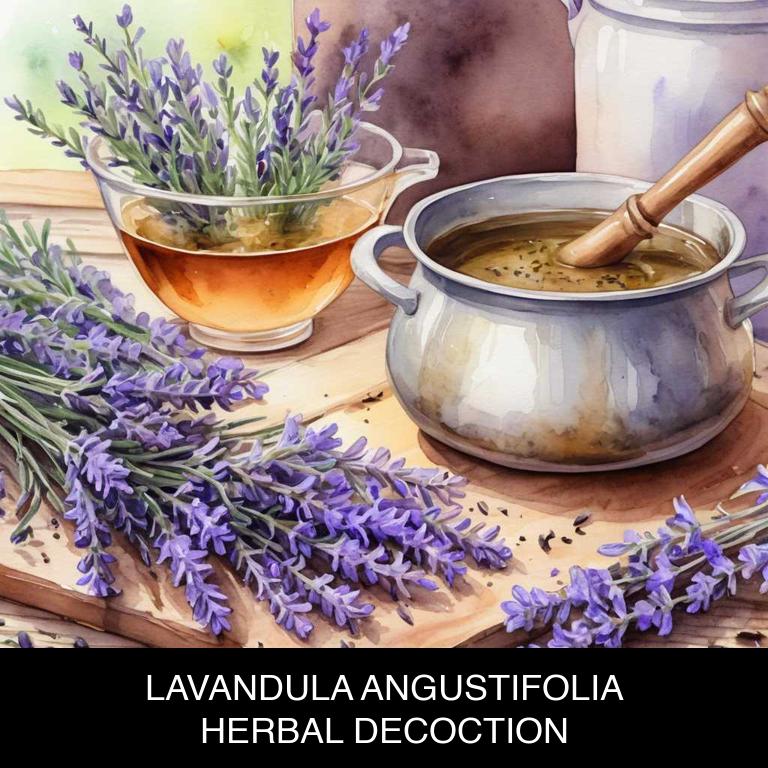
Medicinal Constituents
The list below shows the primary medicinal constituents in Lavandula angustifolia decoctions that help with insect bites.
- Linalool: A terpene found in Lavandula angustifolia decoctions, linalool has anti-inflammatory and antiseptic properties, which help reduce swelling and prevent infection at the site of an insect bite.
- Linalyl acetate: Another terpene in Lavandula angustifolia decoctions, linalyl acetate has potent anti-inflammatory and analgesic effects, which help alleviate pain, itching, and redness associated with insect bites.
- Lavandulol: A sesquiterpene alcohol in Lavandula angustifolia decoctions, lavandulol has antimicrobial properties that help combat bacterial infections, which can occur as a result of an insect bite.
Parts Used
The list below shows the primary parts of english lavender used to make decoctions for insect bites.
- Leaves: Leaves of Lavandula angustifolia are used to make decoctions for insect bites due to their antiseptic and anti-inflammatory properties.
- Flowers: Flowers of Lavandula angustifolia are used to make decoctions for insect bites due to their soothing and calming effects.
- Stems: Stems of Lavandula angustifolia are used to make decoctions for insect bites due to their ability to reduce itching and inflammation.
Quick Recipe
The following recipe gives a procedure to make a basic english lavender for insect bites.
- Harvest 20-30 grams of dried lavandula angustifolia flowers at peak bloom for optimal potency and aroma.
- Grind the dried flowers into fine powder using a mortar and pestle to enhance bioavailability.
- Combine 2-3 grams of the ground flowers with 100ml of boiling water in a heat-resistant glass container.
- Steep the mixture for 10-15 minutes to allow the active compounds to infuse into the water.
- Strain the decoction through a cheesecloth or fine-mesh sieve into a clean glass container for storage.
10. Matricaria chamomilla
Chamomile decoctions helps with insect bites because of its anti-inflammatory, antiseptic, and soothing properties.
When applied topically to itchy bug bites, chamomile's gentle calmer cools the skin, reducing redness and swelling. Its natural astringent qualities also help to dry out weeping blisters, making them less prone to infection.
Additionally, chamomile's mild antihistamine effects can alleviate itching and discomfort, providing quick relief from the annoyance of insect bites.
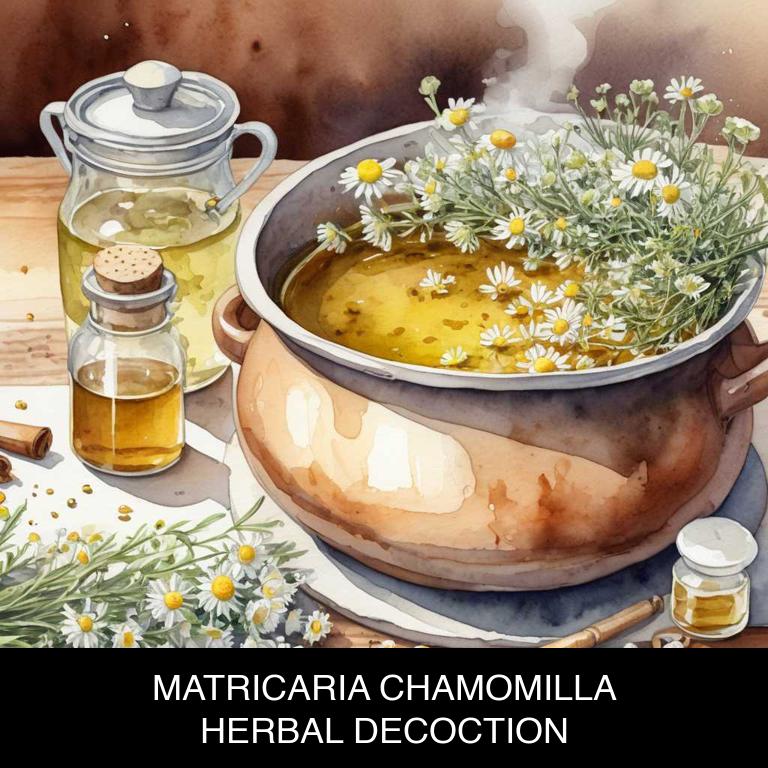
Medicinal Constituents
The list below shows the primary medicinal constituents in Matricaria chamomilla decoctions that help with insect bites.
- Apigenin: A flavonoid that has anti-inflammatory and antihistamine properties, which help to reduce swelling and itching caused by insect bites.
- Bisabolol: A sesquiterpene alcohol that possesses anti-inflammatory and antiseptic properties, which help to soothe and calm the skin affected by insect bites, reducing the risk of infection.
- Chamazulene: A sesquiterpene that has anti-inflammatory and antiseptic properties, which help to reduce redness, swelling, and itching caused by insect bites, while also preventing infection.
Parts Used
The list below shows the primary parts of chamomile used to make decoctions for insect bites.
- Flowers: The flowers of Matricaria chamomilla are used to make decoctions for insect bites because of their anti-inflammatory and soothing properties.
- Leaves: The leaves are used in decoctions to help reduce itching and swelling caused by insect bites.
- Roots: The roots of Matricaria chamomilla are used to make decoctions for their antiseptic and anti-inflammatory properties, which help to soothe and heal insect bite wounds.
Quick Recipe
The following recipe gives a procedure to make a basic chamomile for insect bites.
- Gather dried matricaria chamomilla flowers and measure out a dosage of 2-3 grams per 100ml of water.
- Combine the dried flowers with 100ml of boiling water in a heat-resistant glass cup.
- Allow the mixture to steep for 10-15 minutes to extract the herb's active compounds.
- Strain the liquid through a cheesecloth or a fine-mesh sieve into a separate container.
- Discard the solids and let the liquid cool before serving or storing in a sealed container.
What is the best combination of herbal decoctions to use for insect bites?
The best combination of herbal decoctions that help with insect bites is a mix of chamomile, calendula, and plantain.
Chamomile's anti-inflammatory properties reduce swelling, while calendula's antiseptic and antibacterial properties prevent infection. Plantain's soothing and cooling effects ease itching and discomfort. To prepare, combine equal parts of dried chamomile and calendula, and add a teaspoon of dried plantain.
Steep in boiling water, strain, and apply the cooled decoction to the affected area several times a day for relief from insect bites.
What ailments similar to insect bites are treated with herbal decoctions?
Ailments similar to insect bites that are treated with herbal decoctions are skin irritations such as eczema, rashes, and acne.
Herbal decoctions made from plants like aloe vera, chamomile, and calendula can provide relief from itching, inflammation, and redness associated with these conditions.
Additionally, decoctions of herbs like goldenseal and turmeric may help to reduce swelling and ease discomfort caused by insect bites or similar skin irritations.